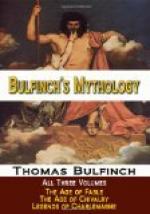KING ARTHUR AND HIS KNIGHTS
I. Introduction
ii. The Mythical History of
England
iii. Merlin
IV. Arthur
V. Arthur (Continued)
VI. Sir Gawain
vii. Caradoc Briefbras; or, Caradoc
with the Shrunken Arm
VIII. Launcelot of the Lake
ix. The Adventure of the Cart
X. The Lady of Shalott
xi. Queen Guenever’s
Peril
XII. Tristram and Isoude
XIII. Tristram and Isoude (Continued)
XIV. Sir Tristram’s Battle
with Sir Launcelot
XV. The Round Table
XVI. Sir Palamedes
XVII. Sir Tristram
XVIII. Perceval
XIX. The Sangreal, or Holy Graal
XX. The Sangreal (Continued)
XXI. The Sangreal (Continued)
XXII. Sir Agrivain’s Treason
XXIII. Morte d’Arthur
THE MABINOGEON
Introductory Note
I. The Britons
ii. The Lady of the Fountain
iii. The Lady of the Fountain (Continued)
IV. The Lady of the Fountain (Continued)
V. Geraint, the Son of Erbin
VI. Geraint, the Son of Erbin (Continued)
vii. Geraint, the Son of Erbin (Continued)
VIII. Pwyll, Prince of Dyved
ix. Branwen, the Daughter of
Llyr
X. Manawyddan
xi. Kilwich and Olwen
XII. Kilwich and Olwen (Continued)
XIII. Taliesin
HERO MYTHS OF THE BRITISH RACE
Beowulf
Cuchulain, Champion of Ireland
Hereward the Wake
Robin Hood
GLOSSARY
KING ARTHUR AND HIS KNIGHTS
CHAPTER I
INTRODUCTION
On the decline of the Roman power, about five centuries after Christ, the countries of Northern Europe were left almost destitute of a national government. Numerous chiefs, more or less powerful, held local sway, as far as each could enforce his dominion, and occasionally those chiefs would unite for a common object; but, in ordinary times, they were much more likely to be found in hostility to one another. In such a state of things the rights of the humbler classes of society were at the mercy of every assailant; and it is plain that, without some check upon the lawless power of the chiefs, society must have relapsed into barbarism. Such checks were found, first, in the rivalry of the chiefs themselves, whose mutual jealousy made them restraints upon one another; secondly, in the influence of the Church, which, by every motive, pure or selfish, was pledged to interpose for the protection of the weak; and lastly, in the generosity and sense of right which, however crushed under the weight of passion and selfishness, dwell naturally in the heart of man. From this last source sprang Chivalry, which framed an ideal of the heroic character, combining invincible strength and valor, justice, modesty, loyalty to superiors, courtesy to equals, compassion to weakness, and devotedness to the Church; an ideal which, if never met with in real life, was acknowledged by all as the highest model for emulation.




